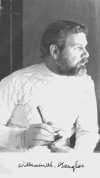
There have been many books written on fencing, excellent ones and others which, though interesting, are less memorable. I wold like to briefly review and strongly recommend several "armchair" fencing books, not treatises on the art per see, but of interest to fencers or any xiphophiliac in general.
I. Sentiments of the Sword, by Sir Richard
Francis Burton.
Sir Richard Francis Burton was a famous Victorian explorer, linguist, and a great devotee of swordsmanship. Though The
Sentiment of the Sword is not as well-known as another of his writings, The Book of the Sword, in many ways I consider the former to be much more interesting. The book is set in the form of a smoking-room dialogue between several upper-class, sophisticated Victorians, who over the course of nine evenings discuss assorted aspects of fencing, centering on the sword's development and its use through the centuries. Though the prose is Victorian and interspersed with French and Latin phrases, Burton's deep knowledge of swordsmanship shines out, making this an invaluable text for understanding Victorian era fencing.
Attatched is a link to an online copy of Burton's book: http://ejmas.com/jnc/jncart_burtonsentimentswordcontents_0300.htm

II. Les Secrets De L'Epee, by Baron Cezar De Bazancourt.
The "Secrets of the Sword" was written at a time when the norm
s of academic
foil fencing were being challenged by the introduction of epee as a fencing weapon. Bazancourt's text is an amazing insight into the revolution of fencing thought that hit late 19th century France. Also set in the form of a smoking-
room dialogue, Les Secrets De L'Epee considers three types of fencing: "graceful athletic exercise...exact science...and practical self-defense" (William M. Gaugler). The contrast between dueling swordplay and academic swordplay is the main focus of "Secrets", in particular the question--of high concern among
fencers at the time--of whether or not epee fencing would render the foil obsolete. If you want to understand why we have both foil and epee in modern fencing, this is the book to read.

III. The Secret History of The Sword, J. Christopher Amberger
Mr. Amberger has put together a delightful compendium of excerpts and
commentary related to European combatives, from the ancient world to the
present. This book is not so much a straightforward history of fencing as much as a tour through some of the most fascinating aspects of western fighting arts. These include firsthand accounts of German mensur duels by the author, an exploration of Greco-Roman combat, Renaissance prizefights, and especially a look at the origins of modern sabre target. I highly, highly recommend this book to all who are interested in anything even remotely related to swords. I would also recommend Mr. Amberger's blog:

IV. On Fencing, Aldo Nadi.
Okay, this is a fencing treatise. However, it is probably the most complete treatise on classical foil fencing that has ever been penned, and was written by one of the greatest fencing minds of all time. Aldo Nadi's words ring with mastery, on a par with Miyamoto Mushashi's Book of Five Rings. I cannot recommend this book highly enough. Read it! More than once!

V. The History of Fencing, William M. Gaugler
If nothing else, Maestro Gaugler's work is definitely the authoritative text on the development of modern European fencing. His prolific scholarship has, in a single volume, covered more than five hundred years of fencing thought, from Achille Marozzo in the 16th century to Giorgio
Pessina in the 20th. This work examines major fencing treatises of each century, examining the development of technical expertise as well as the slow change in fencing from duel to sport. Each text is systematically described, on to the last detail, and while some may not enjoy reading The History of Fencing for long sittings, it is a handy reference to the major developments in the art and science of swordsmanship. Maestro Gaugler's work is an excellent summary of the teachings of great masters of the past, and aids us in understanding where we came from and where we are as fencers today.
VI. L'Ecole Des Armes, Domenico Angelo

The eighteenth century produced many great fencing masters, and Domenico Angelo ranked near the top. Born in Leghorn, Italy, Angelo received his certification as a maitre d'armes from the National Academy in Paris. He moved to London and founded Angelo's School of Arms--l'cole des armes--where both his son and grandson taught well into the 1800's. Among his most famous students were the Prince of Wales, later George IV, and Johann Christian Bach, son of the great composer. In 1763 Angelo published his masterpiece, a classic work on fencing which was instrumental in the development of fencing as a sport. L'Ecole Des Armes saw numerous editions, and was extremely popular. The elegance, poise, and grace which were the hallmark of Angelo's style, can be seen clearly in the book, which outlines the basic principles of swordsmanship and then moves on to the more complicated actions, and finally concludes with instructions on dealing with opponents armed with various weapons, such as smallsword and lantern. The finest feature of Angelo's work, in my opinion, are the lavishly illustrated plates which abound in the text. These are worthy of hanging on a wall to admire, as they accurately capture the elegance of fencing as it was in the 1700's.

